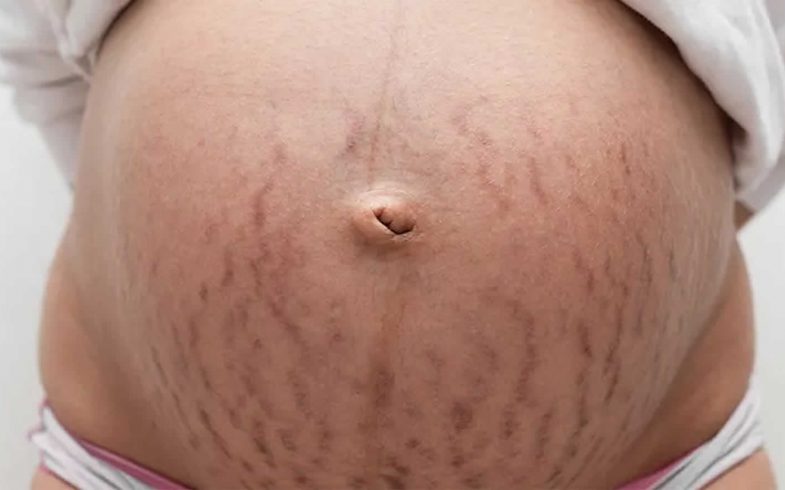STRETCH MARKS DURING PREGNANCY (STRIAE GRAVIDARUM)
Striae distensae are a common form of dermal scarring that appear on the skin as erythematous or hypopigmented linear striations. Synonyms include the terms striae, stretch marks, and striae atrophicans. Striae gravidarum are striae distensae occurring secondary to pregnancy.
There are two main types of striae distensae: Striae Rubra and Striae Alba
Striae rubra are the earliest presentation of striae distensae and are characterized by an erythematous to violaceous color.
Over time, striae rubra evolve into Striae alba, which appear hypopigmented, atrophic, and scar-like .Common locations for striae distensae are the abdomen, breasts, medial upper arms, hips, lower back, buttocks, and thighs.
Although typically asymptomatic, striae distensae may be disfiguring and psychologically distressing to patients. Various topical and procedural modalities have been employed for the treatment of striae distensae.
CAUSES OF STRIAE GRAVIDARUM
Exactly causes of Striae gravidarum is unknown but there is risk factors which can predispose someone to get Striae distensae especially Pregnant women in adolescents age.
RISK FACTORS
Striae gravidarum affect 50% to 90% of Pregnant women . Predisposing factors include pregnancy it self in adolescent age, drug exposure (eg, topical or systemic corticosteroids), underlying disease (eg, Cushing’s syndrome), and surgery.
Studies specifically exploring risk factors for striae distensae secondary to pregnancy (striae gravidarum suggest that striae gravidarum occur more frequently in women with;
●A family history of striae gravidarum
●Higher prepregnancy body mass index (BMI)
●Higher weight gain during pregnancy
●Higher birth weight and gestational age
●Multiple gestation pregnancies
●Polyhydramnios
●Lack of chronic diseases
Increased maternal age seems to protect against striae gravidarum, suggesting counterintuitive differences in stretching ability between older and younger skin. In a series of 800 primiparas examined postpartum for striae gravidarum, 84 percent of 51 women under age 20 developed striae gravidarum compared with only 24 percent of 195 women age 30 or older.
PATHOGENESIS
The pathogenesis of striae distensae is not well understood and is likely multifactorial. Physical factors resulting in increased tension on the skin, intrinsic alterations in skin structure or function, and hormonal factors may be involved:
●Physical factors – A role for mechanical stress on the skin is suggested by the observation that striae often develop in sites experiencing rapid increases in girth (as occurs in pregnancy), rapid weight gain, pubertal growth spurts, and exercise-induced muscle hypertrophy.
●Altered skin structure or function –Striae distensae do not develop in all skin sites subjected to mechanical stress or in all individuals. Therefore, specific characteristics of skin in affected areas may influence development. Reduced migration and proliferation of fibroblasts, reduced procollagen and fibronectin gene expression, marked disruption of the elastic fiber network, and the emergence of thin, disorganized, tropoelastin-rich fibrils have been detected in biopsies of affected skin.
Genetic alterations in connective tissue may contribute to striae distensae. Striae distensae are a common finding in Marfan syndrome.
●Hormonal factors – The common occurrence of striae distensae in pregnancy and Cushing’s syndrome contributes to the theory that hormonal factors influence development of the condition, Potentially relevant observations include:
•Altered expression of hormone receptors, including increased expression of androgen and glucocorticoid receptors and reduced expression of estrogen receptors in the dermis of early striae distensae, have been detected when compared with perilesional skin and normal controls.
•Serum cortisol elevation leads to alterations in collagen and elastic fibers through increased protein catabolism . An example of this is seen in Cushing’s syndrome, where increases in corticotrophin-releasing hormone (CRH), adrenocorticotropic hormone (ACTH), and subsequent increases in cortisol levels lead to generalized protein breakdown, causing skin and muscle atrophy and loss of bone. Cortisol increases free amino acids in serum by inhibiting collagen formation, decreasing amino acid uptake by muscle, and inhibiting protein synthesis.
•Lower serum levels of relaxin (a hormone that can decrease collagen production and increase collagen breakdown) are detected at 36 weeks gestation in women with striae gravidarum compared with women without this finding. It is proposed that the resulting reduced elasticity of connective tissue contributes to greater risk for elastic fiber disruption and striae formation.
CLINICAL MANIFESTATIONS
Striae distensae may initially appear as edematous striations that evolve to the red-to-purple, flat or atrophic plaques known as striae rubra.
Striae rubra eventually progress to striae alba, hypopigmented, scar-like depressions with fine wrinkling. This progression often occurs over the course of 6 to 10 months. Striae alba persist indefinitely and may become more prominent with age as skin thins and loses additional elasticity. In patients with highly pigmented skin, striae distensae may also be dark gray to black (striae nigrae) or bluish (striae caerulea).
Striae gravidarum tend to develop in the second and third trimester of pregnancy and commonly occur on the abdomen, breast, or thighs. Patients with Cushing’s syndrome may have particularly prominent and widely distributed striae. Striae distensae secondary to topical corticosteroid use often occur in intertriginous areas.
PREVENTION
Inoder to prevent of striae distensae you can use topical cream during pregnancy although many women use a wide variety of creams, lotions, and ointments in attempts to reduce risk for striae development, strong evidence to confirm efficacy of any of these interventions is lacking.
Some studies showed that a Pregnant woman can use Olive oil; Cocoa butter; a product containing hyaluronic acid, vitamins A and E, allantoin and can prevent the Striae gravidarum but not effective.
Many “belly band” garments to support the abdomen are marketed to pregnant women. However, efficacy of peripartum or postpartum use for preventing or treating striae distensae is unproven.
Topical retinoids may be beneficial for the treatment of early striae distensae but, due to fetal safety concerns, should not be used for prevention or treatment during pregnancy.
Another treatment is laser therapy where you need to meet a Doctor.


No comments.